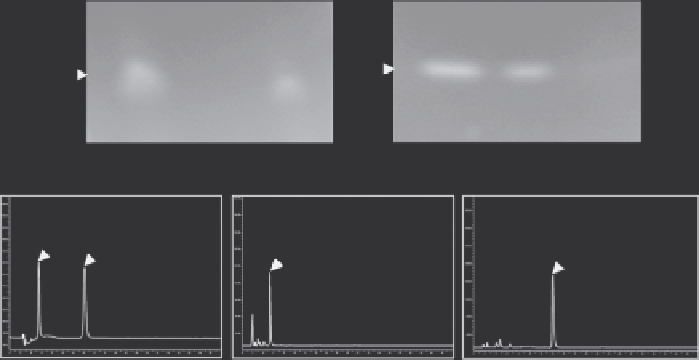Environmental Engineering Reference
In-Depth Information
strainwasnotaffectedbypHintherange5.5-8.5.Degradationofethoprophosbyboth
cultureswasslowatpH5.0.LowpHlevelsarenotfavorableforthesurvivalandgrowth
ofbacteria,ingeneral(KarpouzasandWalker2000).
Ning et al. (2010) report that three epiphytic bacterial species, from the genera
Sphingomonas
,
Acidovorax
, and
Chryseobacterium
, can degrade organophosphorus com-
pounds(e.g.,dichlorvos).TheresultsobtainedbyNingetal.(2010)demonstratethatphyl-
lospherebacteriahavegreatpotentialforbioremediationofpesticidesinsitu,wherethe
environment is hostile to nonepiphytic bacteria. Kambiranda et al. (2009) reported that
theesteraseenzyme(Est5S)wasexpressedinyeasttodemonstratetheorganophospho-
rus hydrolytic activity from a metagenomic library of cow rumen bacteria. The esterase
enzymewastestedfordegradationofchlorpyrifos.Chlorpyrifosdegradationwastested
withthepuriiedenzymeusingthin-layerchromatography(TLC)andhigh-performance
liquidchromatography(HPLC).Chlorpyrifoscouldnotbedetectedinthesamplestreated
withtheEst5Senzyme.3,5,6-Trichloro-2-pyridinol(TCP),theprimarydegradationprod-
uctofchlorpyrifos(CP),couldbedetectedinthechlorpyrifos-treatedsamples(Figure6.6;
Kambiranda et al. 2009). The other eight pesticides were also degraded in the range of
45%-100%,whenusedasasubstratewithEst5Sprotein(Kambirandaetal.2009).
In another paper (De Rofignac et al. 2008), it has been shown that the use of bagasse
compost in a biological bed system is eficient in degrading malathion, glyphosate, and
λ-cyhalothrin.Thebiologicalbeddegradedmorethan99%ofmalathionandglyphosate
after6months.Formalathion,whichhasthelowestK
oc
value,thevolatilizationprocess
shouldartiiciallyincreasethecalculateddegradationrate(DeRofignacetal.2008).Inthe
1
2
3
1
2
3
TCP
CP
(a)
(b)
a
b
c
TCP
CP
TCP
CP
(c)
FIGURE 6.6
TLC (a and b) and HPLC (c) proiles of chlorpyrifos (CP) and 3,5,6-trichloro-2-pyridinol (TCP) by the puri-
iedEst5SenzymeofP.
pastoris
incubatedattemperature40°CatpH7.0for12h.LaneA1,B1,andC1,CP,and
TCPstandard,respectively;laneA2,B2,andC2,Est5Senzyme;laneA3,B3,andC3,inactivationEst5enzyme
(negative control). The TLC plates were developed with chloroform and hexane (4:1, v/v) solvent system for
the detection of CP and ethyl acetate, isopropanol, and NH
4
OH (5:3:2, v/v) system for the detection of TCP,
respectively.TheHPLCwaselutedwith0.5%aceticacidandmethanol(1:4v/v).Thearrowheadsindicatethe
TCP(R
f
value:approximately0.66,retentiontime:approximately5.5min)andCP(R
f
value:approximately0.57,
retentiontime:approximately14min)bandandpeak,respectively.(Reprintedfrom
Pestic. Biochem. Physiol.,
94,
Kambiranda,D.M.,Asraful-Islam,S.Md.,Cho,K.M.,etal.,Expressionofesterasegeneinyeastfororganophos-
phatesbiodegradation,15-20,(2009),withpermissionfromElsevier.)

Search WWH ::

Custom Search